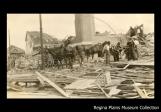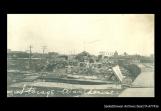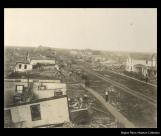1
How the Transportation Network Facilitated Recovery Following the Tornado2
Men cleaning debris near the Canadian Pacific Railway yards after the tornado.1912
Dewdney Avenue, Regina, Saskatchewan

3
Had the 1912 Tornado struck the heart of Paris or London, not only would the consequences have been considerably more dramatic because of the higher density of the built environment and of population in old world cities, the cleanup operations would have been horrendously more difficult as well, because of the way the streets are laid out in old European cities.Unlike Paris and London, Regina was established on a clean slate - virgin prairie - in an age of endless optimism.
The coming of the railway, to which Regina is associated in no small way, meant this territorial capital was destined to expand. It was only fitting that the city plan should reflect the grand aspirations that would become reinforced once Saskatchewan became a province in 1905, and when the Legislative Building would be completed in 1912.
4
Debris along Dewdney Avenue, one of Regina's main thoroughfares in 1912 and still today.1912
Dewdney Avenue, Regina, Saskatchewan

5
Therefore, it made sense to plan for 66-foot wide business and residential streets, interspersed with 99-foot wide main arteries, along a north-south and east-west grid. This plan espoused the Canadian Pacific Railway main line and actually ensured its predominance within the city.7
Regina is a classic railway town. Along the north and south sides of the track, lumber yards were established, from which residential developments would be supplied. The city of Regina is characterized in the years prior to World War I by the accessibility of its territory. The streets are wide and straight - the city is an effective "machine" conceived for the distribution of goods, people and commodities because of the transportation network to which it is attached.Laying an electric street railway system was made easier by the straightness and width of the streets. So were construction activities. One could practically see the next shipment of lumber from Ontario come in by C.P.R. train, if one was building a house along a north-south running street like Smith or Lorne. On the other hand, the grid system is a luxury not affordable in older cities because of the obvious demolition and construction costs that would entail, but not in Regina.
9
Let's think back to the fateful date of June 30th, 1912. The northbound tornado starts cutting across Regina along Smith and Lorne Streets. These are wide streets, probably designed with multi-storey high-rises like those of Chicago in mind. As the sky clears and residents take stock of the extent of the damage, they embark on a massive cleanup effort.It soon becomes obvious that the width of streets is an ally to citizens. The wider streets and the relatively low profile of the built environment ensure it is relatively easy to access the damaged areas with horse-drawn wagons from anywhere along the north-south axis of destruction. This is made easier still by the regular east-west intersecting streets.
10
Horse team and cleanup crew at the site of the Regina Telephone Exchange Building.1912
1761 Lorne Street, Regina Saskatchewan

11
It is also interesting to note that in 1912, there were not only many livery stables that would have welcomed the extra business engendered by the impact of the tornado, there were also dozens and perhaps hundreds of private stables in residential and commercial district backyards with the ability to provide services in the form on wagons for hire with labourers.Nowhere is this more evident than in the Germantown neighbourhood, located just south of the C.P.R. mainline and east of Broad Street. Germantown harboured the highest population density in Regina. There were many hotels, hostels and boarding houses there, and many stables in backyards, with horses in them. This combination of circumstances made it possible for local inhabitants to earn extra revenue, providing much-needed service promptly, thanks to the accessibility to the damaged areas.
12
Cleanup crews with horse teams near the Metropolitan Methodist Church after the tornado.1912
Lorne Street and Victoria Avenue, Regina, Saskatchewan

13
This made it possible for multiple crews to work simultaneously at every affected location within the city of Regina, hauling our refuse and debris; and hauling in new construction materials. That made it possible for Regina to recover from the tornado much more quickly than in many other human settlements.14
Text written by Claude-Jean Harel, MA, MAHIPresident and Founder of the Great Excursions Company
www.greatexcursions.com

